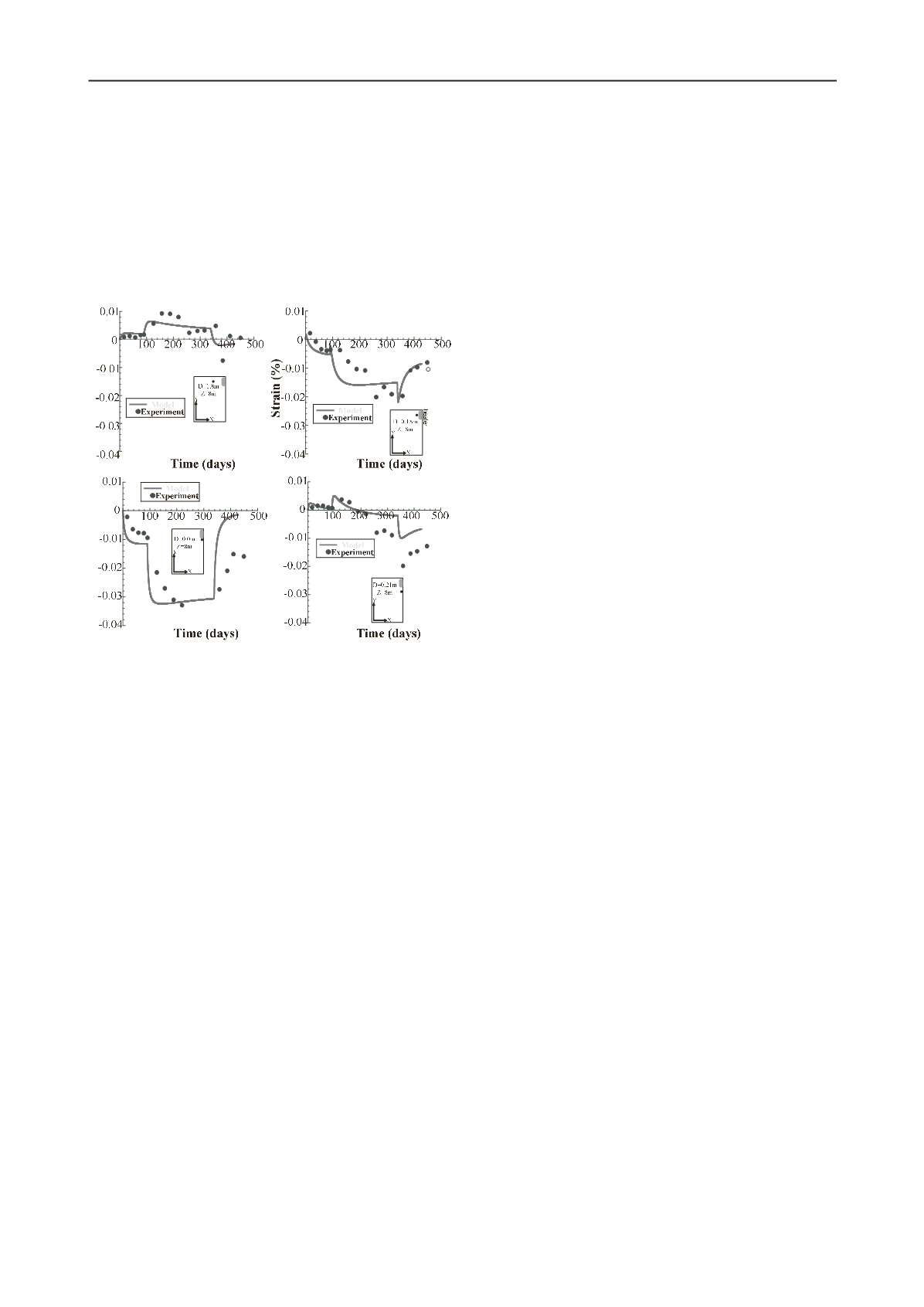
3422
Proceedings of the 18
th
International Conference on Soil Mechanics and Geotechnical Engineering, Paris 2013
when temperature rises up suddenly, and then it will decrease
with time even though the temperature is increasing. The
highest value of EPWP is up to 3MPa. The increase of EPWP is
due to the fact that thermal expansion coefficient of water is
much higher than that of rock. Owing to the low permeability of
rock, drainage is slow and the pore water expansion is impeded,
resulting in the EPWP increase at the beginning. At later time,
as mentioned above, migration of water from the heat source is
gradually accelerated due to the increase of permeability,
allowing pore pressure to dissipate.
heater
heater
heater
Figure 9. Variation of deformation at different position
At the same time, heat-induced deformation is also
investigated. Figure 9 shows the calculated and test results at
different positions. It is found that the calculation can describe
the change of the deformation qualitatively if compared with the
test data. The deformation of the rock near the heater is
expansive; while the deformation of the rock far away from the
heater is contractive. It is very easy to understand that the rock
may behave expansive due to the significant increase of
temperature; nevertheless, the change of temperature at the
places far away from the heater is rather. Therefore, the dilation
of the rock far away from the heater is very small compared
with the rock in the vicinity of the heater. As the results,
swelling force caused by the expansion of the rock near the
heater will cause contraction of the rock far away from the
heater.
4 CONCLUSIONS
In the paper, the following two conclusions can be made:
a) An isotropic element heating test is simulated by the
proposed THM analysis based on an elasto-viscoplastic
model. The calculation can well explain the phenomenon
observed in the test that the heat-induced volumetric strain
measured by water discharge changes from contraction to
dilation with the increase of OCR in isotropic heating
process. In the calculation with THM analysis, soil
skeleton is always dilative with the increase of temperature
regardless of what kind of OCR may be. The discharge of
the water is just caused by different thermal expansion
properties of the soil and the water! In a word, this
phenomenon is merely a boundary value problem with
soil-water interaction, not an inherent property of the rock
itself!
b) A field test of heating process (Gens, 2007) is also
simulated with the same THM analysis based on the same
elasto-viscoplastic model. It is found that the proposed
numerical method can well describe the THM behavior,
such as, the temperature change, the change of EPWP and
the heat-induced deformation.
5 REFERENCES
Baldi G, Hueckel T and Pelegrini R (1988): Thermal volume changes of
the mineral-water system in low-porosity clay soils,
Canadian
Geotechnical Journal
, Vol. 25, 808-825
Cekerevac C. and Laloui L. (2004): Experimental study of thermal
effects on the mechanical behavior of a clay,
International journal
for numerical and analytical methods in geomechanics
, Vol. 28,
209-228
Cui Y. J., Le T. T., Tang A. M., Delage P. and Li X. L. (2009):
Investigating the time-dependent behavior of Boom clay under
thermomechanical loading,
Getechnique
, 59, No. 4, 319-329
Gens A., Vaunat J., Garitte B. and Wileveau Y. (2007): In situ behavior
of a stiff layered clay subject to thermal loading: observations and
interpretation,
Geotechnique
, Vol.57, No.2, 207-228
Jia Y., Wileveau Y., Su K., Duveau G. and Shao J. F. (2007): Thermo-
hydro-mechanical modeling of a situ heating experiment,
Geotechnique
, Vol.57, No.10, 845-855.
Zhang S. and Zhang F. (2009): A thermo-elasto- viscoplastic model for
soft sedimentary rock,
Soils and Foundations
, Vol. 49, No. 4, 583-
595.


